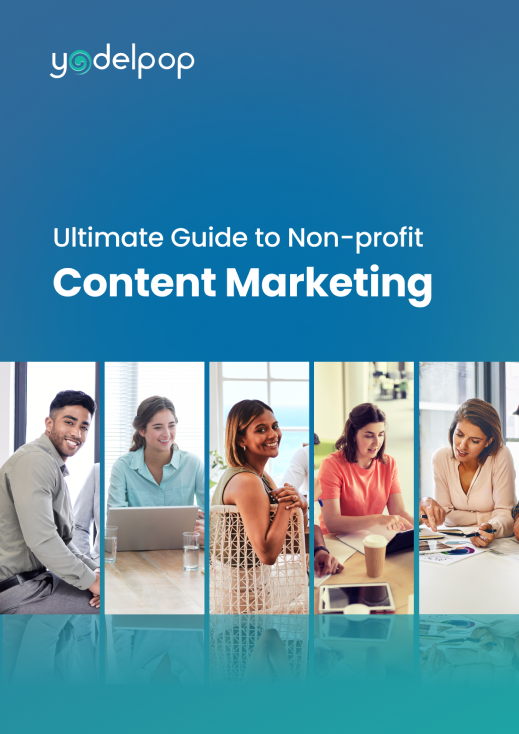
The Ultimate Guide to Nonprofit Content Marketing

Nonprofits can and should engage in content marketing. It not only helps your organization achieve your education mission and get supporters—it also helps make the internet a better place to find information on important issues.
This page will help you understand
- What content marketing is
- How search engine algorithms have changed best practices for publishing content
- How your nonprofit can use content marketing today
- What you need to do to get started
Defining Content Marketing
One way to define content marketing is by its formats, such as:
- Blogs
- Ebooks
- Videos
- Webinars
- White papers
- Case studies
- Infographics
But there are many other forms that content marketing takes. And just because content is published in one of these ways, that doesn’t make it marketing.
Another widely cited definition of content marketing (published both by HubSpot and the Content Marketing Institute) is: “a strategic marketing and business process focused on creating and distributing valuable, relevant, and consistent content to attract and retain a clearly defined audience, and ultimately, to drive profitable customer action.” But that’s clearly a business-oriented definition.
For nonprofits, the following definition of content marketing may be the most useful. Nonprofit content marketing is a strategic process of:
- creating and distributing valuable, relevant, and consistent content,
- in order to attract and retain a clearly defined audience, and ultimately,
- to drive that audience to take actions that advance your organization’s mission.

Organizations often choose to embark on content marketing because it’s more cost-effective than outbound marketing tactics such as paid advertising and direct mail: content marketing gets three times more contacts than paid search advertising, according to the Content Marketing Institute.
But there’s another reason to engage in content marketing, and to do it well: You’re actually improving the quality and breadth of content people can find online about the issues you’re working on, and that’s a boon to your mission in and of itself.
Content Marketing & Your Mission
In order for your organization’s content marketing to be worth the investment it takes to be successful, it needs to align with and advance your mission as an organization. But the mission of your content is not the same as the mission of your organization.
If your nonprofit is planning to engage in content marketing or is currently engaged in it, then you need a content mission statement. When you determine why you’re creating content, that informs what content you need to create. Reversing the order of those decisions results in content that’s less likely to show results that are meaningful to the organization. Your organization’s content mission sets the tone for your entire content marketing strategy and ensures that the purpose of the content is aligned with the purpose of the organization.
Justin Champion at HubSpot provides this template for creating a content mission statement, which is useful for organizations of all types:
Our mission is to [fill this in], but when it comes to our content strategy, it’s not about doing that, it’s about the idea that everyone should know how to [fill this in].
Other resources for crafting your content mission statement include these two blogs on the Content Marketing Institute website:
- The One Brief Statement That Will Refine Your Content Marketing (by Michele Linn)
- Why You Need a Content Marketing Mission Statement (by Joe Pulizzi)
The Ghost of SEO Past
Once you’ve articulated your content mission statement, it’s time to step outside your organization and look at the work you do from a totally different perspective: the perspective of people who know nothing about you. But they do have some connection to the issues you’re working on, and chances are they’re researching those issues, in some way, using digital media.
Content marketing exists solely because of the technology that makes it possible. It’s the technology that people are using to find information in order to meet their own needs, challenges, and desires. It’s Google (and Facebook, and YouTube, and every other search-driven platform). That’s why, in order to be an effective content marketer for your nonprofit, you need to have a basic understanding of how search has changed.
Google rolls out 500 to 600 minor algorithm changes each year, according to Moz. In addition, it occasionally rolls out a major algorithmic update that affects search results in significant ways. Recent ones include:
- Panda
- Penguin
- Hummingbird
- Mobile Friendly
- RankBrain
Search algorithm updates over the past few years have brought us to an interesting point as content marketers:
Search algorithms were responsible for a massive increase in business blogging in the 2000s and early 2010s. Back then, best practice was to publish short pieces of content (blogs) as frequently as possible to get found by your organization’s ideal audience or personas. Each blog was to incorporate a different longtail keyword. Links and calls-to-action (CTAs) from blogs to landing pages with forms completed the marketing funnel, giving your organization a method for attracting visitors and converting them to contacts for your database so that you could email them.
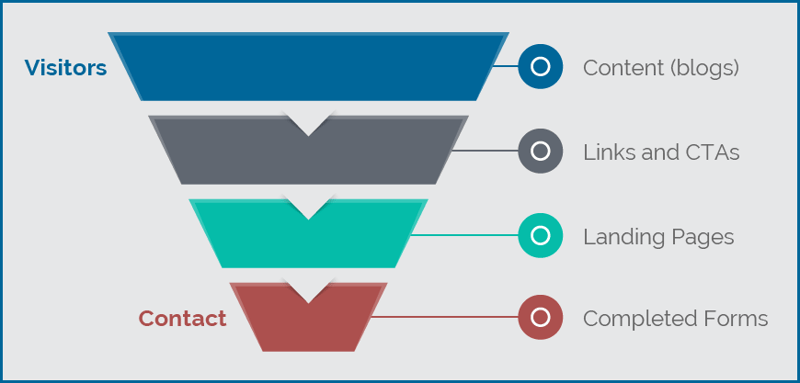
Yodelpop’s experience working with clients confirmed what we were being told was best practice in content marketing: To go from basically no organic traffic to ranking for relevant keywords, attracting visitors, and building a database of contacts required many organizations to publish 104 blogs every year.
That’s a lot of content.
And publishers were rewarded for their productivity. Traffic did increase, and if CTAs were in place, organizations were now able to generate leads from people who were interested in their content.
How to Win at SEO Now
Google’s recent major algorithm changes have created a different search landscape. The new world of SEO is one in which the most successful content marketers:
- Build visibility across topics, rather than keywords
- Provide answers to questions
- Publish long, authoritative pages
- Form all of their content into a set of topic clusters with carefully planned internal links
Google has moved to rewarding publishers for answering the questions that users are asking. Queries have become more conversational, amplified by the rise of mobile and voice search.
Organizations are being awarded higher visibility when they publish long, authoritative pages on a core topic, with secondary rewards being given for pages that provide useful information on subtopics of that core topic. Because so much search is happening using artificial intelligence (AI), these subtopics are often phrased as answers to a specific question.
As a result of what happened earlier in the century, today many organizations find their content to be in one of two states:
- Chaos: If you had or found the resources to invest in an active content marketing strategy, you may now have hundreds or thousands of blogs, many essentially on the same topics, forming a thick but messy undergrowth on your website. And that undergrowth typically includes blogs that are getting 0 visits per month and others with monthly visits in the hundreds or thousands.
- Oblivion: If you never found the resources to invest in high-frequency content marketing, you may have kept doing business as usual, publishing a blog when you had some news to broadcast — an upcoming event, or a recently completed project — or whenever the spirit moved you. Because it was not targeted to attract visitors who were researching topics related to your mission, this content is doing little to nothing to grow the base of your organization.
Meanwhile, larger enterprises and institutions continue to hold the majority of online market share by investing in content that users will find when they search.
But even an organization whose content is in a state of chaos or oblivion can put together an effective content marketing strategy that will get them found by the right people. Here are the basic pieces of an updated content marketing strategy.
Keyword Research: SorryYou Still Have to Do It
With all the changes in search, you might think researching actual keywords is passe. But it isn’t. It’s just gotten a lot easier, thanks to the many tools that take human behavior into account and combine different aspects of the data that Google makes available. Paid keyword research tools include:
- Google Ads Keyword Planner, which is provided when you open a Google Ads account
- HubSpot's SEO tool, part of its all-in-one marketing software
- Keywords Everywhere, which you install as an API, and then it becomes part of your Google search page
In addition, there are many free tools available online. Find the one that works best for you and share it across your organization so you’re all looking at the same data; different tools compile search volume differently, but what’s important is that you’re doing an apples-to-apples comparison.
Better Nonprofit SEO Through Topic Clusters
To many of us, the fact that search is rewarding well-organized content is a big relief. Generating as many blogs as possible squanders resources that nonprofits could be channeling toward valuable work. Instead, organizations now can plan content using topic clusters to tell a whole story that makes the case for their mission while answering the public’s questions, as validated by search data.
A topic cluster is a group of content centered on one big topic that is an important part of your organization’s story. An organization that provides care to seniors might have a topic cluster on dementia care:
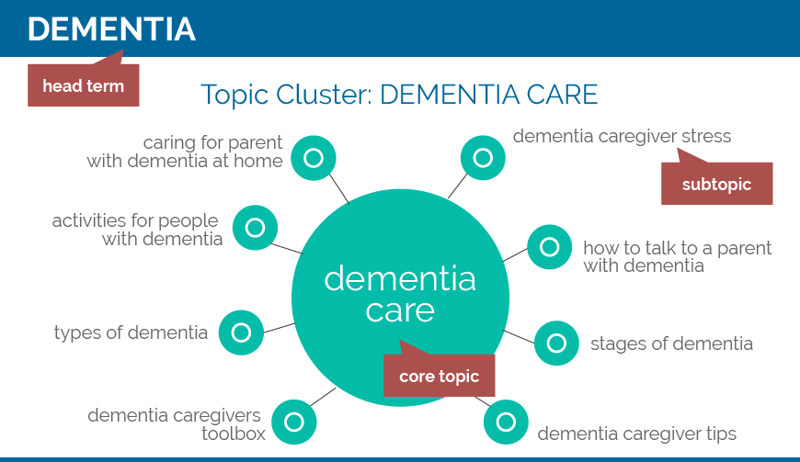
Below, we’re going to reverse-engineer this topic cluster to show you how it was built. You can use the same steps to build a topic cluster for your own organization. In the process, you’ll be planning a pillar page and a set of blogs to support it. This content will be strategically planned to attract your supporter personas to your website, educate them on a crucial aspect of your mission, and engage them in taking action on that mission by, for example, supporting your organization.
Planning topic clusters for your organization involves choosing a set of big topics that:
- Your supporter personas are asking questions about
- Are important to your organization’s mission
Start by looking back at your content mission, described above. What do you want your supporter personas to know how to do? Can you divide that answer into a set of bullet points? Our sample organization’s content mission look like this:
Our mission is to provide high-quality assistive care with compassion and respect, but when it comes to our content strategy, it’s not about doing that, it’s about the idea that everyone should know how to:
- Provide excellent care for an aging parent (for family caregivers) or the seniors in their care (for professional caregivers)
- Successfully manage and reduce caregiver stress
- Find and choose high-quality senior care providers
With your content mission in front of you, you can move on to draft your first topic cluster. Some key components of a topic cluster include:
- Head term
- Core topic
- Subtopic
Head Term
A head term is a top-level phrase with a high monthly search volume that supports your programs/services. From the final portion of your content mission, draft a list of head terms. Looking at the first bullet point in our example, we know it’s important to us that family caregivers know how to provide excellent care for an aging parent. Based on our work in this field, we know that dementia is one of the big topics that caregivers need information on.
Our keyword research tells us dementia gets 673,000 searches per month. It’s a fine head term — we’re just using it to group our content in a way that makes sense to our organization, not to compete with anyone for search.
Core Topic and Pillar Page
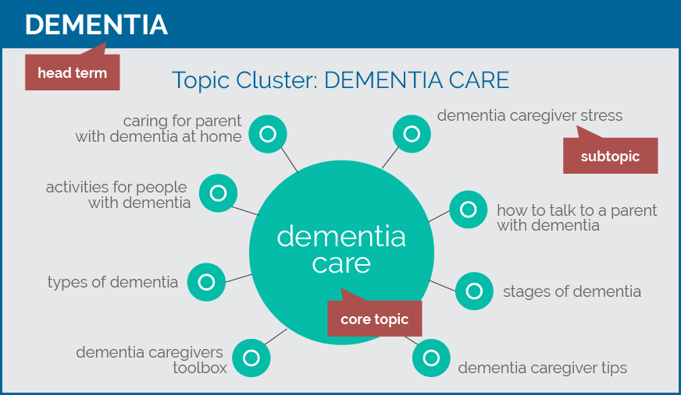
Next comes our core topic. You’ll most likely be generating a number of core topics under a single head term. A core topic represents a topic that’s smaller than your head term, but still a big topic in relative terms, considering your overall content mission. It is a longtail keyword, three to five words long, that is a phrase used by one or more of our key personas to research a topic that they’re especially interested in.
Use the challenges and goals portions of your personas to determine your core topics, and consider carefully the fact that your content mission is to make sure your personas possess specific pieces of knowledge. When it comes to search volume, as a rule of thumb, the search term you’re targeting for your core topic (we’ll call this the core term) will have monthly searches in the thousands — less than your head term, and usually more than your subtopics (see below).
Within dementia, our head term, our content mission requires us to deliver content that helps our personas provide excellent care to a relative or patient, so dementia care could be our core term. This term comes in at 6,600 searches per month, so it seems to qualify. But to really make sure, we need to look at the practical application of this core term — how we plan to use it. We need to look at how it would work as the keyword for — and topic of — a pillar page.
How to Create a Successful Nonprofit Pillar Page
A core term is at the center of a pillar page on your website. This is the long, authoritative page that, if it’s done right, Google will reward your organization for publishing. If your core term isn’t pillar page material, it’s best to go back and come up with another one.
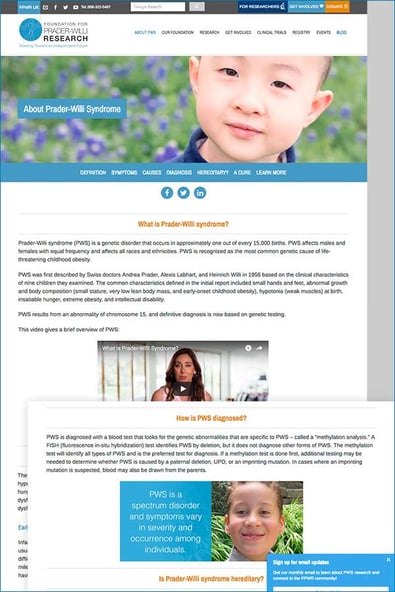
How can you tell if your core term will make for a good pillar page keyword?
Start by Googling the term and looking at the first page of search results. Answer this one question: Can your organization make a page that is ten times better than the ten pages you see listed (ignore the ads at the top)?
What does it mean to make a page that is ten times better? It’s not just about the design, or the content. It’s a combination of the two. Here are some of the elements of a successful pillar page:
- Long, authoritative content: 2,000 words at a minimum — you cannot have too much content, as long as it’s valuable to your persona and relevant to the core topic and the page is designed well
- Embedded video
- Great user experience (is it easy to find and use all of the content?)
- Excellent mobile as well as desktop interface
- A menu just for that page, using anchor titles in subheads
- Graphics such as infographics and photos
- Inline CTAs
- Form to download the page content as PDF
- Share buttons
- Perfect SEO: optimized titles, subheads, meta descriptions, image tags and file names, content, etc.
When evaluating whether you can compete with an existing page, don’t look at just one measure of success, such as length. One way you can win is by finding gaps in other pages and filling them on your page. Also look at the outright quality of the content through your personas’ eyes. Do you have access to stories, data, images, etc., that your competitors don’t have, because of the great work you do? This is where your mission can make you shine.
If you find that the core term you’re considering has too much competition, move on; find a core topic where you can win. Don’t waste your resources creating more noise online. Look for chances to provide value—even if your next core term has lower monthly searches. You’ll be narrowing your audience to a niche group that can really benefit from your message and engage meaningfully with your work.
Sub Topics & Blog Posts
Once you have a core topic that you’re planning to build a pillar page around, it’s time to decide on some subtopics within that same topic cluster. These are going to become the keywords for your blogs (you can also build other content around them, like web pages and videos). And these blogs (and other pieces of content) are all going to contain links to the pillar page. Because the goal here is to boost traffic to the pillar page — and to the topic cluster as a whole.
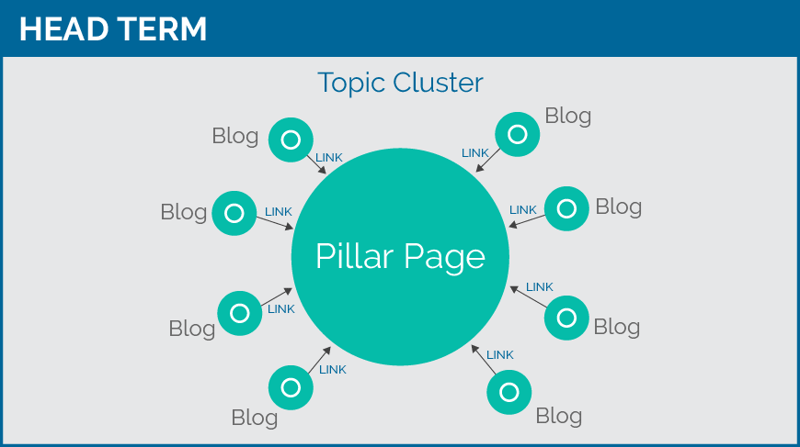
If you’ve used blogging as a marketing strategy for your organization in the past, you already know a lot about writing blogs around a keyword. In case you’re new to the task, here are the basics:
- Create a list of questions that your personas have, which are specific aspects or facets of your core topic, based on their challenges and problems — you should have many sources of these based on your work, including your staff, volunteers, members, and constituents
- Each one of these questions is a potential subtopic — it will be the subject of a blog, with its own unique keyword
- Use your favorite keyword tool (there are several listed above) to find the keywords users are entering to find information on these issues, along with related searches, and the average monthly search
- Enter potential subtopic keywords into Google and use the results to determine what demand there is for this content, and to generate more ideas. Look at:
- Autocomplete: What is Google entering for you?
- The first page of the search engine result listings: Can you create better content than what you see there?
- Synonyms, similar phrases, and lots of different ways of asking the same question
Subtopic keywords can be relatively low in traffic, with monthly search volume in the hundreds, or even less. The key is to answer the right questions to address your personas’ challenges and goals and to achieve your organization’s content mission.
In the case of our topic cluster example, under our core term of dementia care, we’ve decided to start with these subtopics as keywords for our blogs:
- dementia caregiver stress
- how to talk to a parent with dementia
- activities for people with dementia
- stages of dementia
- dementia caregiver tips
- types of dementia
- dementia caregivers toolbox
- caring for parent with dementia at home
Each blog needs to be as perfectly optimized for search engines as your pillar page, including your keyword in: the page title (in an H1 tag), subheads (in H2 and H3 tags), meta descriptions, image tags, image file names, and — of course — the content. However, gone are the days of keyword stuffing — search engines will penalize you for it, and so will your visitors. Use the keyword naturally — which argues for choosing a keyword that makes that possible.
Remember you are writing for the human, not the search engine.
Each subtopic is a step toward increasing visibility and traffic for the pillar page it is connected to; make it relevant so that your pillar page link will be completely natural in the blog.
In many cases, especially if you’re creating all of your content from scratch, all of the subtopic blogs combined will essentially comprise the content of your pillar page. But each piece has to work on its own, so keep in mind that each blog will need to be customized.
Once you know what the subtopics (blog topics) in your topic cluster are going to be, you need to generate content. For overextended nonprofit staff, that can seem like a barrier, but it may not be as hard as you think. Here’s a quick list of possible sources of blog content. They may require some work to adapt into blogs, but in some cases you should be able to virtually cut and paste:
- Presentations by experts at your conference — transcribe, edit, and attribute to them, embedding the video for even better traffic
- Fact sheets
- Articles from your enewsletter, magazine, or journal
- Annual reports sharing success stories and metrics
- Emails written to individuals in response to their questions
- Personal stories of your volunteers, advocates, or others—place a form on your website soliciting these
- Social media—further develop posts your team has written or replies to comments that they’ve crafted
- Donor appeals
- Interviews
- Old blog posts—find disparate blog posts and combine them to increase their combined traffic—just make sure to create redirects or you could lose, rather than gain, traffic. (If you’re doing this, it’s best to enlist the help of a professional versed in repurposing content. At Yodelpop, we’ve developed a whole process for consolidating content and repurposing it for higher traffic and conversion—feel free to contact us to learn more about it.)
While your organization has the expertise in your subject matter—either on staff or in your network of advocates, members, and volunteers—you may not have professional writers. Hiring a content marketing firm that specializes in nonprofit mission-driven organizations is one solution; they can draw from your materials, interviews with your experts, and additional research to create the content your audience is looking for. If you don’t have the resources to hire professionals, create a simple assignment template that clearly lists the parameters of the blog assignment (word count, topic, use of the keyword, required link to pillar page, required subheads, and bullets, etc.) and fill it out every time you ask someone to write for your blog.
How many subtopics will you need? In the end, the number of subtopics you generate (and blogs you create) to be in your topic cluster will depend on how much your personas want to know — and, of course, how much content and expertise your organization has on the subject. While quantity is still important, it has taken second place to quality in the new SEO.
The difference between the old way of keyword-based blogging and blogging that’s based on topic clusters is this: All of your blogs will now be working together to drive traffic to a pillar page. Traffic to the entire topic cluster is what matters most, not traffic to any single blog.
Rather than looking at traffic to any one blog as your main metric of success with content marketing, you can now consider how the whole topic cluster is doing at (1) attracting traffic and (2) converting visitors to leads (with calls-to-action, on-page forms, and pop-up forms).
Getting Started
Content marketing using a topic cluster approach can be intimidating. Don’t get discouraged. Make a priority to, in the next year:
- Create your content mission.
- Complete just one topic cluster: You don’t have to do them all at once. And you don’t have to get millions of visits; also work toward more conversions (new contacts in your database), more time spent on your pages, and a lower bounce rate.
- Develop a framework so that you can “wash, rinse, and repeat” — your next topic cluster will be easier!
- Be patient; this is a long-term strategy.
By organizing your content within topic clusters instead of individual disjointed posts, you’ll capture a larger amount of search traffic across an ever-increasing pool of relevant keywords, convert more of your ideal supporters into contacts, and increase support for your organization.
A marketing firm that specializes in helping nonprofits plan and carry out content marketing can be helpful. Yodelpop can help you with your nonprofit’s content marketing.
Want a portable version of this article?
DOWNLOAD IT HERE.

Want a portable version of this article?
